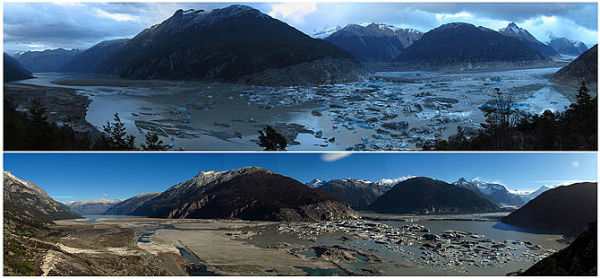What happens when a huge lake disappears overnight? A disaster of epic proportions, that’s what! In the mountains of Chile's southern Patagonian region of Aysén, Lake Cachet II is formed by the massive but shrinking Colonia Glacier. The ice historically has dammed a valley to form a lake about two square miles in extent. But now as the warming South American climate allows the lake water to tunnel through the glacier, the ice structure is periodically weakened, as reported in the Huffington Post:
The disappearance was dramatic, but it was no mystery. The lake had vanished just two months before, on January 27, and 10 times in the past five years. It happens every time that rising temperatures weaken the glacier enough for water to tunnel all the way through the ice wall… on March 31, 2012, the entire lake disappeared overnight. The sun rose on a dry, sandy valley spotted with puddles and large chunks of ice. Ninety feet of water had vanished in a matter of hours.

When this happens, the breakup is catastrophic both at the lake site and for miles downstream. Those who live in the valley and depend upon the lake for fishing or a dependable water supply are literally left high and dry until the glacier creeps forward again and temporarily dams the stream. Down river, the consequences are more frightening:
Two hundred million cubic liters of water gushed out into Chile's largest river, the Baker, creating giant waves 60 miles downstream, as far as the river's mouth at the Pacific Ocean.
The rapid disappearance of these glaciers on which people depend will continue to have massively disruptive effects on the lives of South Americans, on both sides of the Andean mountain chain. According to a United Nations report, the glaciers of Patagonia are “losing mass faster and for longer than glaciers in other parts of the world.” This means, of course, a huge and progressive loss of dependable fresh water available on the coast, where most people on the continent live.
This story also raises significant questions in environmental ethics, since these periodic abrupt changes in water level are very disruptive both for the fish and other aquatic organisms that live in lake, and for species that rely upon it as their source of food. The enormous torrents of rushing water also wreak havoc along tens of kilometers of riparian environment on their way to the Pacific Ocean. This tragic disruption of Andean ecological stability and the well-being of human communities may be one of the more glaring symptoms of rapid global climate change.
